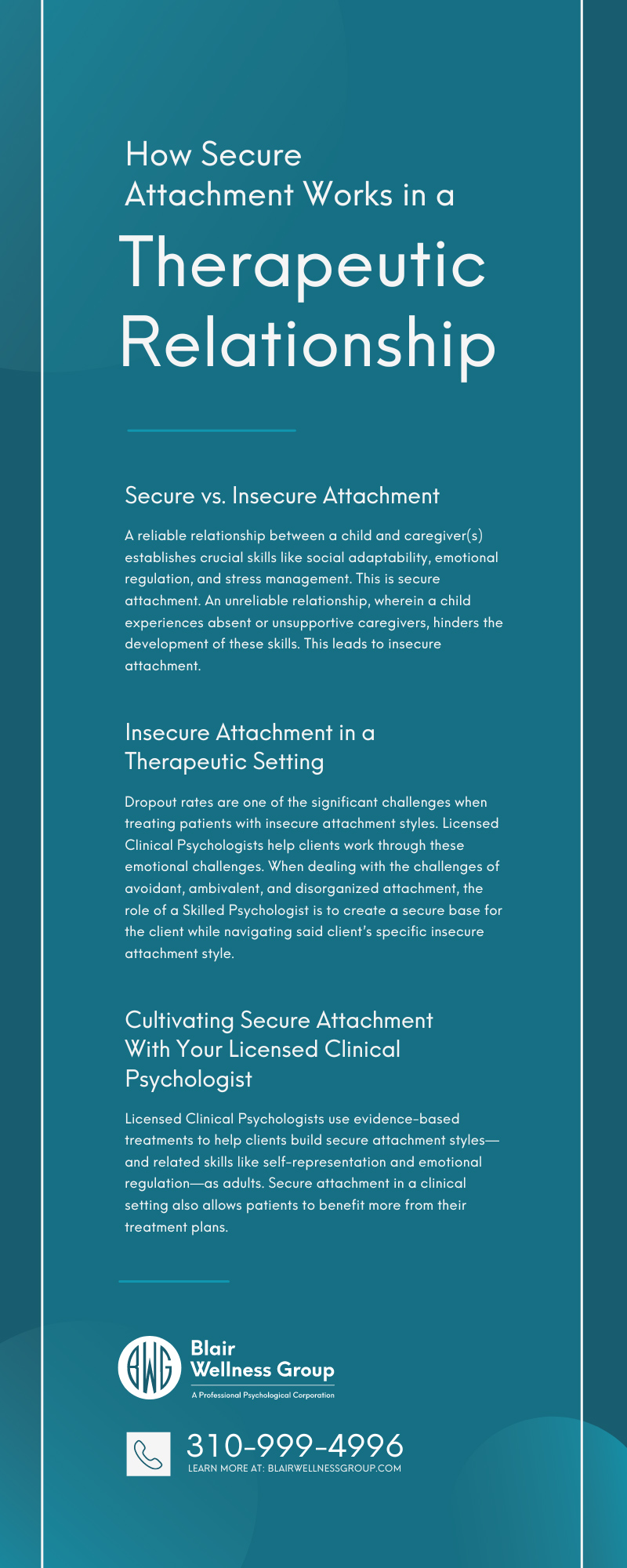Attachment styles begin developing in infancy but continue to influence relationships, mental health, and behavioral health for the rest of your life. Secure or insecure attachments play a role in diagnosing and treating Mental Health Disorders. Licensed Clinical Psychologists evaluate and use their client’s attachment styles to provide more comprehensive and focused treatment.
Just as an insecure attachment can hinder mental health, secure attachment can help it. There is a strong correlation between clients developing a secure attachment with treatment providers and the successful treatment of psychopathology, Addiction Disorders, Mood Disorders, and Personality Disorders. Read on to explore how secure attachment works in a therapeutic relationship.
Secure vs. Insecure Attachment
Attachment defines how you relate to others in relationships—especially close relationships. Your attachment style affects how you interact with your parents, children, romantic partners, etc.
Attachment style develops during infancy and childhood based on the emotional bond (or lack thereof) that you experienced with your parents or primary caregivers. A reliable relationship between a child and caregiver(s) establishes crucial skills like social adaptability, emotional regulation, and stress management. This is secure attachment. An unreliable relationship, wherein a child experiences absent or unsupportive caregivers, hinders the development of these skills particularly stress regulation and modulating affect in times of stress or in the context of interpersonal relationships. This leads to insecure attachment.
Different Forms of Insecure Attachment
In essence, a child who grows up with unreliable or strained relationships with their primary caregivers learns that they cannot or should not rely on others to offer comfort or fulfill their needs. Specific forms of insecure attachment can develop based on the environment and relationships you grew up with. These forms are avoidant, ambivalent, and disorganized attachments.
Avoidant Attachment
Avoidant attachment, also known as dismissive or anxious-avoidant detachment, revolves around dismissing emotional and physical intimacy in the name of strict independence. Individuals with an avoidant attachment style often struggle with expressing emotions and trusting others. This often leads to dismissing relationships, believing you don’t need close relationships, and even feeling threatened by others’ attempts to get close to you. As a result, individuals with avoidant attachment struggle to reach out to others when they need guidance, assistance, or other forms of emotional or social support.
Ambivalent Attachment
Ambivalent attachment is also commonly referred to as anxious-ambivalent or anxious-preoccupied attachment. Individuals with ambivalent attachment styles are sensitive to any sign of rejection and often require constant validation and reassurance from others or they will act out in very destructive ways to undermine all relationships. This can lead to compulsive care-seeking and impulsive attention-seeking behavior that others will regard as clingy, demanding, exhausting, and needy. Because of their fear of rejection or abandonment, many individuals with ambivalent attachment styles rely heavily on romantic partners, friends, associates, and others for constant validation. They might also depend on others for the emotional regulation skills they did not develop in childhood. For this reason, ambivalent attachment often leads to struggles with codependency.
Disorganized Attachment
Disorganized attachment often stems from experiencing extreme inconsistency or trauma during childhood years. This attachment style leads to a lack of real coping strategies, making it hard for individuals to navigate real-world relationships, academic and professional experiences, and social situations. Individuals with a disorganized attachment style struggle with a fear of rejection, the inability to express emotions properly, severe anxiety, paranoia, and difficulty trusting others.
Insecure Attachment in a Therapeutic Setting
Insecure attachment styles create challenges in all important and meaningful relationships. Those challenges are also present in client-psychologist relationships. As a result, a patient’s attachment style plays a significant role in the success of therapeutic outcomes, and the ability to comply with treatment plans effectively.
Dropout rates by patients suffering from Insecure Attachments are one of the most significant challenges when treating patients with Personality Disorders, Mood Disorders, and Trauma, which have all resulted from insecure attachment styles in childhood. Patients with avoidant attachment often struggle to commit to ongoing treatment or engage properly in respecting boundaries when interacting with their Psychologist or Mental Health Providers. Those with ambivalent attachment might quit treatment and treatment due to perceived abandonment or the fear of rejection. And those with disorganized attachment might stop treatment after feeling remotely attached or reliant on their treatment providers.
Licensed Clinical Psychologists help clients work through these emotional challenges. When dealing with the challenges of avoidant, ambivalent, and disorganized attachment, the role of a Psychologist is to create a secure base for the client by creating consistency, accountability, structure, and natural consequences within defined boundaries while navigating the client’s specific insecure attachment style.
Cultivating Secure Attachment With Your Licensed Clinical Psychologist
Licensed Clinical Psychologists use evidence-based treatments to help clients build secure attachment styles—and related skills like self-representation and emotional regulation—as adults. Secure attachment in a clinical setting also allows patients to positively benefit from their treatment plans without attention seeking or acting out. Secure client-psychologist relationships lead to better patient treatment compliance and stronger therapeutic alliances.
As Licensed Clinical Psychologists help clients work past their fear of trust, abandonment, and other attachment issues, they empower client engagement and effective treatment sessions. Moreover, clients who develop secure attachments in a clinical setting are able to stick with their treatment plans, benefit from them, and conclude their treatment successfully.
Secure Attachment and the Treatment of Mental Health Disorders
Insecure attachment styles go hand in hand with many Mental Health Disorders, including Addiction Disorders, Mood Disorders, and Personality Disorders. Psychologists use a variety of evidence-based treatment modalities to help clients understand the effects of childhood experiences on attachment styles, develop emotional and behavioral skills, and build secure attachments within and beyond the clinical setting.
Mentalization-Based Treatment
Mentalization-Based Treatment (MBT) teaches patients how to identify their own emotional state, others’ emotional states, and the link between feelings and actions. This skill is known as mentalization. Mentalization-Based Treatment helps patients establish a more dependable sense of self—a trait often lacking in individuals with insecure attachment styles. With a stronger sense of self and clearer emotional regulation, individuals can maintain relationships that are neither too detached (as is the case with avoidant attachment) nor too dependent (as is the case with ambivalent attachment).
Transference-Focused Psychotherapy
With Transference-Focused Treatment (TFP), Skilled Psychologists aim to explore clients’ thoughts and feelings about close relationships—such as one’s relationship with their parents—by projecting those emotions toward the treatment provider. This process of transference gives Licensed Clinical Psychologists insight into the poor childhood experiences and the negative internalized thoughts behind the client’s struggles. TFP allows Licensed Clinical Psychologists to correct symptoms and unhealthy behaviors that stem from insecure attachment.
Expert, Client-Focused Treatment at Blair Wellness Group
Learning how secure attachment works in a therapeutic relationship is only the first step toward building a secure attachment style and healing from your Mental Health Disorders. Take the next step when you work with Blair Wellness Group. Find a Licensed Clinical Psychologist who knows how to address attachment style in the context of Personality Disorder treatment and other Mental Health Conditions at Blair Wellness Group today.

Dr. Cassidy Blair is a renowned Licensed Clinical Psychologist and trusted Performance Coach who specializes in providing Concierge-Psychological Care and Executive Coaching for high-achieving professionals. With a deep understanding of the unique challenges faced by CEOs, executives, entrepreneurs, and leaders, Dr. Blair offers tailored, confidential care designed to foster emotional well-being, personal growth, and professional excellence. Her clientele values her discretion, clinical expertise, and emotionally intelligent approach to navigating complex personal and professional dynamics.
- This author does not have any more posts.




